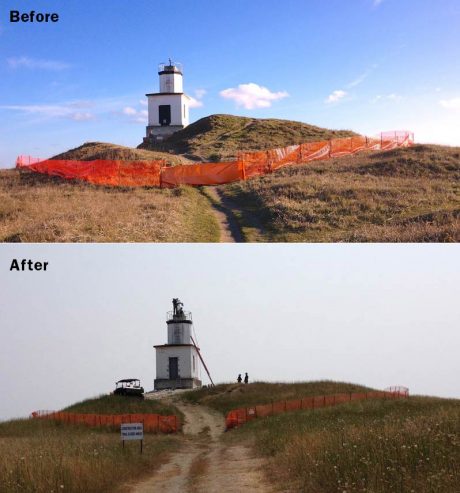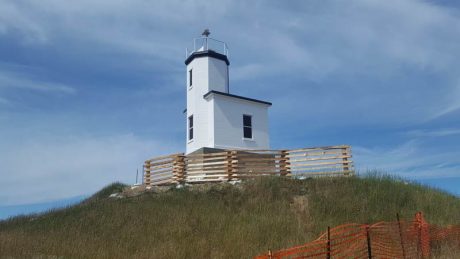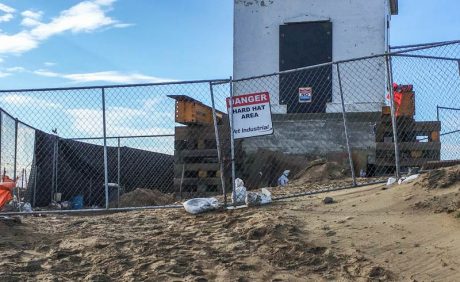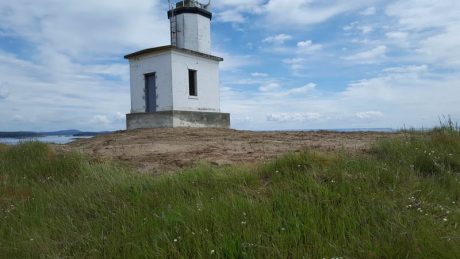Lighthouse Restoration
Posted August 31, 2017 at 5:55 am by Tim Dustrude
“A house built upon sand ….”
Sometimes there’s no choice: the same sand that destabilizes a lighthouse is shifting under the water and making the lighthouse even more necessary.
The lighthouse at Cattle Point was built in 1935 and has stood ever since. The sand was mostly stabilized by the strong roots of the grass growing around it.
But generations of visitors tramping around the building finally destroyed the grass, and the sand was blowing away, undercutting the building by approximately 40 percent.
“It seems likely that the lighthouse will be turned over to the new San Juan Islands National Monument,” according to Marcia deChadenedes, monument manager, “though I can’t say for certain — decisions like that are made above my pay grade!” but first it had to be made sound, itself, and safe for the public to visit.
Vet Industrial of Bremerton won the bid and has been working out there since June. The building was jacked up and a new concrete foundation built under it.
Gary Vestman, superintendent at Vet Industrial, said the building was “in pretty precarious shape — I couldn’t believe it.” He told of standing on the top in February in a high wind, “and I could feel it moving under me.”
He said he got off pretty promptly.
Much of the sand and dirt supporting the building had blown out from under it, and formed higher ground to the west, so that soil was used for backfill. Looking at the before and after pictures you can see the change in terrain.

Cattle Point Light before and after construction to shore up the foundation – Louise Dustrude photos
Ultimately what will hold the sand in place is the strong grasses (and their roots). Green Man Landscape & Design of Friday Harbor has been contracted to plant the sorts of grasses that will hold. Jason Suhl, co-owner with his twin brother Adam, explained that “grass has been salvaged from the site and kept in burlap to be re-planted.”
In addition, Green Man employee Glenn Hendrick has been conferring with Eliza Habegger, land steward with the Land Bank, on grass restoration. Together the two women have come up with a mix of seeds and plugs that will be planted in October once the winter rains can be counted on.
“It would be a waste of money to plant out there now, since there’s no way to irrigate,” Jason said.
The Land Bank is growing 3000 plugs for the project — primarily a hybrid of Roemer’s Fescue and Red Fescue — and Green Man is purchasing eight other varieties of seeds from a number of regional nurseries.
The structure will remain behind a construction fence for the balance of the year to allow the new vegetation to take hold. A new route to the building is also in the planning so that the wind pattern won’t have the same opportunity to cut into the trail as it did in the past.
—
If you’re interested in participating in a Friends of Cattle Point Light and helping to tell the story of the area, email Nick Teague, gteague@blm.gov to learn more.
Story by Louise Dustrude
You can support the San Juan Update by doing business with our loyal advertisers, and by making a one-time contribution or a recurring donation.
Categories: Government, Transportation
One comment:













One comment...
Nice story, Louise.
Here’s to Cattle Point Light! It took a lot of moving parts coming together to bring this project to fruition. Thanks to Marcia deChadenedes, Nick Teague, the Land Bank, Green Man Design and Vet Industrial for demonstrating that partnerships work.
By submitting a comment you grant the San Juan Update a perpetual license to reproduce your words and name/web site in attribution. Inappropriate, irrelevant and contentious comments may not be published at an admin's discretion. Your email is used for verification purposes only, it will never be shared.